| |
|
|
| |
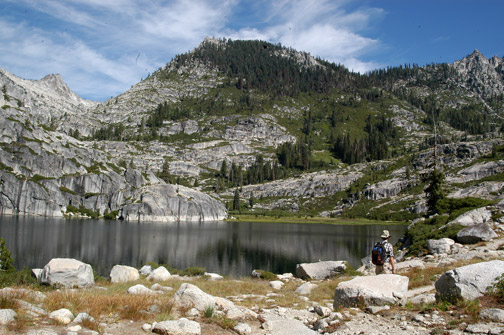 |
|
| |
Hiking along Upper Canyon Lake |
|
| |
|
|
| |
Trying to take the measure of a 525,000-acre wilderness area is something that can’t be done easily or quickly. For decades I had heard tales about the Trinity Alps Wilderness Area, the half-million-acre plus wilderness in far northern California. Friends came back with glowing reports of its rugged isolation, sparkling mountain lakes and otherworldly landscape.
After too many years of deliberation, Steve Underwood and I set aside a week-plus for exploring the Trinity Alps. We ended up splitting our trips into two segments. Phase one was a five-day backpack to Grizzly Lake, a strenuous 35-mile round trip trek that included a 4,650-foot elevation gain, river crossings where the water was knee-high and a grueling “scramble” up a tricky, frequently invisible route to the dazzlingly scenic lake. |
|
| |
|
|
| |
|
|
|
|
| |
Steve Underwood tries his fishing luck at Grizzly Lake |
|
Grizzly Falls, the outlet for Grizzly Lake, explodes over a dramatic drop to the basin hundreds of feet below |
|
| |
|
|
| |
While reviving in Weaverville, a fascinating city full of history, good restaurants and a cozy hotel, Steve and I thumbed through “The Trinity Alps: A Hiking and Backpacking Guide,” by Luther Linkhart and Mike White. We were enticed by the introduction to the Canyon Creek Lakes and El Lake trek where the authors advised: “If you can take only one trip into the Trinity Alps, Canyon Creek is probably your best choice.”
Canyon Creek indeed has it all—sparkling waterfalls, a trail that passes through forests of oaks, dogwoods, big leaf maples, madrone, white and red firs, Jeffrey and sugar pines, incredible vistas and a trio of beautiful high mountain lakes. And, with a round trip distance of about 17 miles, it can be enjoyed in two or three days. |
|
| |
|
|
| |
Lower Falls is a tempting place for a swim along the Canyon Creek Trail |
|
| |
|
|
| |
On the hike in, I joined other swimmers in the luscious, dive-into-temptation pool at Lower Canyon Creek Falls, the first set of a trio of easy-to-access falls along the trail. Later in the afternoon, instead of camping at Lower Canyon Creek Lake, which has limited camp areas, or Upper Canyon Creek Lake, which tends to draw a majority of backpackers, we claimed a wide-open site off the Boulder Creek Trail just a short distance from Boulder Creek. Instead of toting full packs to the series of lakes, the following day we carried much lighter day packs for our out-and-back visit to Lower and Upper Canyon Creek lakes and El Lake. |
|
| |
|
|
| |
 |
|
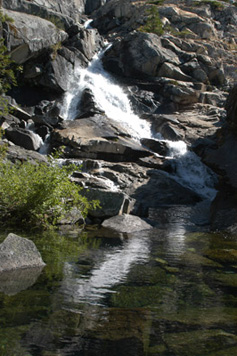 |
|
| |
Hikers along the Canyon Creek Trail |
|
Upper Falls rumbles from out of Lower Canyon Creek |
|
| |
|
|
| |
All three lakes are dazzling, and all have different, individual features. The hike to El is described as a scramble, but after the challenge of reaching Grizzly Lake—an exhausting, challenging climb and descent—the route to El was like walking a freeway. From several spots, vistas offer magnificent views of Lower and Upper Canyon Creek lakes. Our turnaround point, the 2-acre El Lake, is set in a cirque and is named for its “L” shape. It feels, and is, wondrously remote. |
|
| |
|
|
|
|
| |
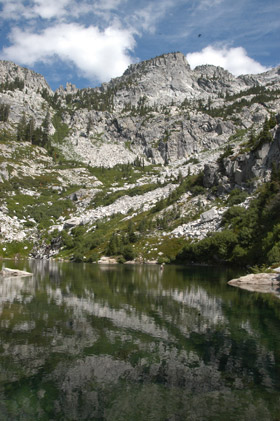 |
|
 |
|
| |
Towering granite cliffs rise dramatically from El Lake |
|
Steve Underwood takes a quick nap on a large, fallen log at El Lak |
|
| |
|
|
| |
Is Canyon Creek the best backpacking choice in the Trinity Alps? It might require a few years, and a lot more hiking, to decide. |
|
| |
|
|
| |
Jorstad Cabin |
|
| |
|
|
| |
There’s much to say about the hike to Grizzly Lake, especially via the route we took from the Hobo Gulch trail head. The trail, even more so than Canyon Creek, offers plentiful river views as it courses along the North Fork of the Trinity River. Part of the fascination is the area’s human history, including the remains of cabins lived in by years-ago miners. But most involving of all is the Jorstad Cabin. Unlike other cabins, which are in various stages of decay, Jorstad’s remains intact. It’s an incredible relic of a time past. Adding to its intrigue is the story of the man who built and lived in the cabin. Portions of Jorstad’s story are told in a book, “Behind the Wild River,” published in 1995. But more revealing is a multi-page history apparently kept only at the cabin. |
|
| |
|
|
|
|
| |
 |
|
 |
|
| |
Sign outside the Jorstad cabin |
|
Jorstad’s 1937 cabin still stands |
|
| |
|
|
| |
“ ‘Wifey, honeybunch, my love, let’s hold off a while buying that house,’ ” Jorstad wrote of his 1937 plea to his bride, Adzie, of his efforts to thwart her plans for a domestic life in Northern California’s Mill Valley. “ ‘The world is wide and full of interesting places to live and things to do … Let’s take a vacation, a complete one. Quit our jobs and go look. We might find a better way to live.’ And, don’t you know, she took me up.”
Jorstad’s better way was Pfeiffer Flat, a meadow along the Trinity River. It was there, about eight trail miles from the place the gravel road that begins in Junction City ends, that the son of Norwegian immigrants took his bride in May 1937.
Until his death in 1988, Jorstad lived and, in his older years, periodically returned to Pfeiffer Flat and the sturdy cabin that still stands. That first year is chronicled in “Behind the Wild River.” But it’s the cabin’s history that reveals other aspects of his not always comfortable life. |
|
| |
|
|
| |
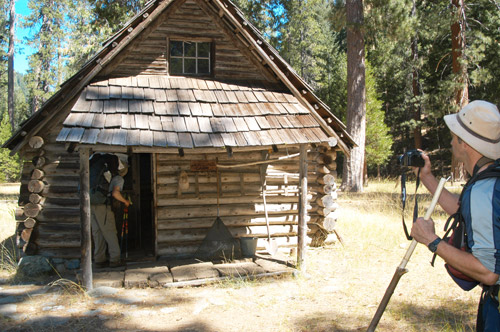 |
|
| |
Backpackers check out the Jorstad Cabin |
|
| |
|
|
| |
In his book, Jorstad gushes, “Imagine a broad flat along the river, fairly open, set about with giant firs and pines, park-like in appearance, covered with grass growing out of a deep bed of fertile. What a find!” It’s a description that’s still fits.
Jorstad laid out the cabin by compass so, as he explains in his notes, “it is not magnetic north-south, but sidereal north-south, thus making it the cabin itself a clock and a calendar. From a few small calculations you can determine the hour of the day, and the month of the year, from the shadows inside—useful information in the far back woods.” |
|
| |
|
|
| |
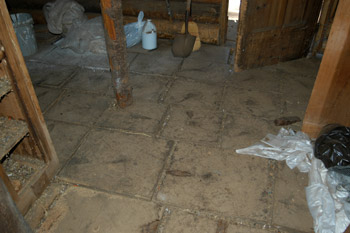 |
|
|
|
| |
Squared off rounds create unusual floor |
|
Cabin corners were skillfully cut |
|
| |
|
|
| |
Unusually, Jorstad created a floor by taking 10-inch thick cedar rounds and squaring them off so that, as he wrote, it created “a warm, dry floor that will last forever.” |
|
| |
|
|
| |
 |
|
| |
The cabin awaits Jorstad’s return |
|
| |
|
|
| |
The cabin notes offer glimpses of backwoods life, including “three rocking chair miners,” or people collecting unemployment insurance, a miner and his “somewhat notorious wife” and another miner stricken with cancer who “ended it all with a bullet.”
Adzie ended her time at the cabin in 1941, leaving to return to San Diego and a job. “It was a sad parting,” Jorstad writes in his notes. “We clasped hands, kissed and said goodbye. This left me to sit alone on the doorstep contemplating the riddle of Mankind and our place in it.”
There’s more, much more, to Jorstad’s story. Read the book, visit the cabin, read the notes, contemplate your own life’s riddles. Become part of Pfeiffer Flat and Jorstad’s ongoing legacy. |
|
| |
|
|
| |
 |
|
| |
Steve Underwood at the cabin door |
|
| |
|
|
| |
If You Go |
|
| |
|
|
| |
Several books offer advice on day and overnight hikes into the Trinity Alps Wilderness. By coincidence, we both relied on “The Trinity Alps: A Hiking and Backpacking Guide,” fourth edition, by Luther Linkhart and Mike White, $17.95, the Wilderness Press, www.wildernesspress.com .
The book has descriptions of more than 500 miles of trail and cross country route, 34 hiking trips and includes eight maps that show local roads and the described trails.
To learn more about W.O. “George” Jorstad and his cabin, read “Behind the Wild River: A Search for a Better Way to Live.” In the book, Jorstad, tells the story of the first year he and his wife Adzie built and lived in a cabin on a mining claim on the North Fork of the Trinity River. Published in 1995 Trinity Publishers Services, it is available for $14.95 from the Trinity County Historical Society’s Jake Jackson Memorial Museum in Weaverville, Calif., 530-623-5211, jake@trinitymuseum.org or www.trinitymuseum.org |
|
|

